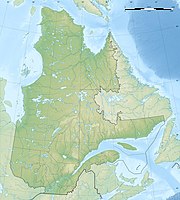Réserve écologique Charles-B.-Banville
|
Réserve écologique Charles-B.-Banville
|
||
| location | Rimouski-Neigette , Quebec, Canada | |
| surface | 10 km² | |
| WDPA ID | 23117 | |
| Geographical location | 48 ° 13 ' N , 68 ° 9' W | |
|
|
||
| Setup date | 1994 | |
| administration | MDDEP | |
The Réserve écologique Charles-B.-Banville is an ecological reserve in the south of the Canadian province of Québec , in the county of Rimouski-Neigette .
It is located about 40 km southeast of Rimouski on the territory of the cantons of Ouimet and Flynn . The reserve was established in 1994 on an area of 1000 ha.
It protects and represents a part of the Appalachian Mountains of the lower St. Lawrence River , which is characterized by fir - yellow birch forests , but also by those in which paper birch , black spruce or red stem moss ( Pleurozium schreberi ) specify the fir forests in more detail .
The area includes a hill about 200 m high. The height differences are rather small, there are hardly any steep falls, and there are a few small lakes in the reserve.
The bedrock is about 390 to 440 million years old and belongs to the Chaleurs group. Different types of sandstone , slate , argillite (a black talc schist ) and basalt predominate. After the last Ice Age, this layer was covered by Tillit , a geological soil layer that is thin in the higher areas and stronger in the lower areas. Podzol and brown earth are the soil types that dominate here.
In the higher elevations you can find the mixed forests of fir, yellow, birch and paper birch, and sugar maple on the eastern slope. In addition to the other species mentioned, the occidental tree of life ( thuja ) also occurs occasionally . The elm is also found in the lowest layers.
The area is inhabited by black bears, moose, white-tailed deer and chipmunks ( Tamia ), known only in Canada as suisses . Then there is the collar chicken .
The name of the reserve refers to Abbé Charles-Borromée Banville (1925–1984), who started the first Opération Dignité in 1970 , an initiative that wanted to prevent the small communities in the hinterland from being dissolved. Banville worked on it until 1973 and wrote Les Opérations Dignité in 1977 for the Fonds de recherches forestières of the Université Laval . The forest resource was no longer the focus of attention as an object of the exploitation of wood, but in a considerably wider perspective, which also allowed completely different uses that did less harm to the forest.
Web links
- Réserve écologique Charles-B.-Banville , government website
Remarks
- ^ Charles Banville: Les Opérations Dignité , Fonds de recherches forestières de l'Universitè Laval, 1977.
